

In this Waste Today article, Sam Cooke discusses the factors, treatment options, analytical methods, and identifying PFAS sources to most effectively reduce the concentrations of ammonia and PFAS in landfill leachate.
Reducing these concentrations help meet discharge permit requirements for direct discharge of treated leachate to surface waters and to meet publicly owned treatment works (POTW) discharge permit standards.
Sam points out that accomplishing ammonia and PFAS reduction with established wastewater treatment technologies works, but the right treatment depends on each site’s specific parameters. He suggests conducting bench-scale and pilot-scale testing for any feasible nitrogen removal or treatment system. Testing the wastewater helps to identify any changes in the concentration of nitrogen compounds. Thus, necessary changes to the treatment processes, such as additional aeration or chemical additions are easier to identify and less costly to implement.
Best practices for treating ammonia in landfill leachate, Waste Today
About the Author: Mr. Cooke, PE, CEM, MBA, is a Vice President and our expert on Industrial Waste Pretreatment. He has nearly three decades of professional and project management experience in engineering with a concentration in environmental and energy engineering. Mr. Cooke works within SCS’s Liquids Management initiative to provide services to our clients nationwide.
Learn more about liquids management at landfills.
Lindsey is an employee-owner at SCS Engineers on the solid waste management team performing Construction Quality Assurance – CQA and reporting for field projects, as well as OM&M on landfills and assisting with landfill reporting and compliance.
Lindsey earned her BS in Soil and Waste Resources—Waste Management from the University of Wisconsin—Stevens Point in the Summer of 2018. She currently serves on the SWANA Badger Chapter Board and is co-YP Liaison, plus participates in SCS’s Young Professionals program.
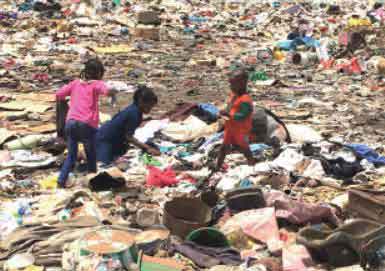 Lindsey recently published an article Finding Solutions for an Open Dumpsite: Solid Waste in The Gambia in the April edition of the Badger Chapter YP Newsletter.
Lindsey recently published an article Finding Solutions for an Open Dumpsite: Solid Waste in The Gambia in the April edition of the Badger Chapter YP Newsletter.
The Gambia, is a tiny sliver of a country in West Africa, has a population of just under 2.5 million. About a fourth of the country’s population is under the jurisdiction of the Kanifing Municipal Council (KMC) – the most densely populated area of The Gambia. The people and leadership of the Kanifing municipality are united in their desire to have positive changes in solid waste management in the community and at the Bakoteh dumpsite. Ideally, solving the problem will implement a means of positive change for many aspects of the KMC citizens’ lives.
 Outside of work, Lindsey is a self-described “bird nerd” who has two parrots: A Green Cheek Conure (7 years old) and a Yellow-Naped Amazon (34 years old). She often volunteers at Feathered Friends Sanctuary and Rescue where they provide care for around 65 surrendered parrots.
Outside of work, Lindsey is a self-described “bird nerd” who has two parrots: A Green Cheek Conure (7 years old) and a Yellow-Naped Amazon (34 years old). She often volunteers at Feathered Friends Sanctuary and Rescue where they provide care for around 65 surrendered parrots.
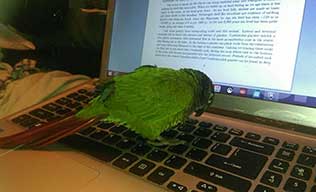
Scientists and experts agree that climate change is a present-day threat to communities across the U.S., manifesting in both predictable and unpredictable ways. As detailed in the National Climate Assessment Vol. 4 (NCA4), coastal storms are increasing in strength and frequency, forest fires are becoming much larger and more destructive, annual precipitation is changing and increasing in variability, and widespread flooding is becoming more common both in the interior of the nation and along the coasts.
These changes present complex challenges to the waste management industry that must be addressed and planned for. For example, one challenge is an increasing frequency of large-scale weather events and natural disasters, which are creating more debris that must be managed and which affects the characteristics of landfilled waste. Landfill design needs to incorporate precipitation changes and increased threats due to weather variability, flooding, and sea-level rise. Precipitation changes affect gas generation rates and require a diligent reaction to maintain effective gas collection. Because of weather pattern changes, risks of cover material erosion and swales have increased for landfills in both wet and dry climates, which may require stronger natural caps or the use of emerging technologies for alternate cover. Additionally, landfills are affected by an increase in the variability of precipitation and rapid changes between weather extremes.
It is clear that waste management facilities must adapt to these changes in addition to scenario building for pandemics to maintain effective operations. Adaptations available include making changes to landfill design and planning, such as incorporating precipitation changes into the modeling of leachate and gas generation or increasing the distance between the bottom liner and groundwater.
Systems should be regularly evaluated and areas needing repairs should be corrected quickly and diligently. Gas generation models should be updated regularly and collection systems need to be expanded or adjusted to account for precipitation increases or decreases.
More frequent and intense storms are creating challenges for cover material management, liquids management, and maintaining slope stability. Facilities should implement innovative uses of both existing technology and new or emerging technologies.
Communities with waste management facilities should include waste management infrastructure in emergency management plans, including maintaining landfills and collections operations and using landfills as both temporary debris storage and as an option for final disposal.
Since climate change effects vary by region and locale, many facilities are developing a specific plan for adaptation and management. To reduce the inevitable costs of adaptation and maintain responsiveness to weather changes, a reactive approach is being abandoned in favor of a proactive approach.
 About the Author: Jacob Shepherd is a Senior Project Professional specializing in air compliance and reporting within EPA Region III. He is experienced in environmental engineering, air compliance, renewable energy, landfill and landfill gas engineering, and environmental services throughout the mid-Atlantic region, and is a licensed P.E. in Virginia.
About the Author: Jacob Shepherd is a Senior Project Professional specializing in air compliance and reporting within EPA Region III. He is experienced in environmental engineering, air compliance, renewable energy, landfill and landfill gas engineering, and environmental services throughout the mid-Atlantic region, and is a licensed P.E. in Virginia.
Resources and Recovery
Get started with these resources and recovery success studies; click to read, download, or share each:
Contact for assistance starting or refining your plan ahead of natural disasters and pandemics. We offer these services:
Planning for Natural Disaster Debris – help for communities to develop or revise a disaster debris management plan. Many aspects of disaster debris planning can be relevant to communities demolishing abandoned residential buildings and remediating properties.
Guidance about Planning for Natural Disaster Debris – much of the construction or demolition waste can be recovered and recycled. SCS Engineers designs and builds these facilities so we can help locate the nearest C&D debris recyclers as part of your plan.
Planning Financial Response and Recovery – the SCS Management Services™ team offers services to support financial planning and to quickly access budget and operational financial impacts. Eliminate concerns about the upcoming fiscal year expectations and anticipated medium-term impacts of pandemics and natural hazards on local government operations and revenue streams. Address issues such as:
Pilot-Testing a Novel “Concentrate-&-Destroy” Technology for ‘Green’ and Cost-Effective Destruction of PFAS in Landfill Leachate
One of the recent recipients of EPA’s latest round of small business research grants is investigating a novel technology for treating PFAS in leachate. This project could fill a key technology gap for cost-effectively treating PFAS in landfill leachate. The technology would provide landfill field engineers and decision-makers with a cost-effective solution and mitigate the health impacts as the relevant regulations are rapidly evolving.
Per EPA:
The technology is based on an innovative adsorptive photocatalyst (Fe/TNTs@AC) synthesized by modifying low-cost activated carbon (AC) with a cutting-edge photocatalyst, iron-doped titanate nanotubes (Fe/TNTs). The technology works by first concentrating PFAS in water onto Fe/TNTs@AC, and then completely degrading PFAS under UV or solar light. Bench-scale studies indicated that Fe/TNTs@AC can remove >99% of PFOA or PFOS from water via adsorption within 1 hour and degrade nearly 100% of the adsorbed PFAS within 4 hours of UV irradiation. Complete destruction of PFOA also regenerates the material, allowing for repeated uses.
While conventional AC or resins do not degrade PFAS, and while PFAS-saturated AC or resins are hardly regenerable, PFAS on Fe/TNTs@AC are amenable to efficient photocatalytic degradation, which not only destroys PFAS, but regenerates the material. While direct photochemical treatment of PFAS-laden water is often cost-inhibitive, the new technology employs photocatalytic treatment only for spent Fe/TNTs@AC, which is only a fraction of the raw water volume, and thus consumes much less energy.
Phase I commenced on March 1 and runs through August 31, 2020
For more info, see:
Landfill Leachate – Information and Resources
EPA’s Interpretation of “Begin Actual Construction” Under the New Source Review Preconstruction Permitting Regulations
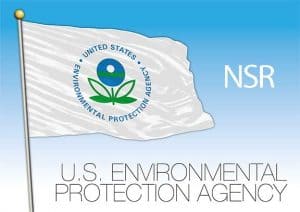 This EPA guidance addresses EPA’s interpretation of when an owner or operator must obtain an NSR permit for a major stationary source or major modification before the start of actual construction on the facility. Currently, EPA considers almost every physical on-site construction activity that is of a permanent nature to constitute the beginning of “actual construction,” even where that activity does not involve construction “on an emissions unit.”
This EPA guidance addresses EPA’s interpretation of when an owner or operator must obtain an NSR permit for a major stationary source or major modification before the start of actual construction on the facility. Currently, EPA considers almost every physical on-site construction activity that is of a permanent nature to constitute the beginning of “actual construction,” even where that activity does not involve construction “on an emissions unit.”
The interpretation fails to give meaning to the distinction between an emissions unit and a major stationary source. As such, it tends to prevent source owners/operators from engaging in a wide range of preparatory activities they might otherwise desire to undertake before obtaining an NSR permit. For this reason, EPA is adopting a revised interpretation that is more consistent with the regulatory text.
The proposed revised interpretation will stipulate that a source owner or operator may, prior to obtaining an NSR permit, undertake physical on-site activities – including activities that may be costly, that may significantly alter the site, and/or are permanent in nature – provided that those activities do not constitute physical construction on an emissions unit.
Begin actual construction means, in general, initiation of physical on-site construction activities on an emissions unit, which are of a permanent nature. Such activities include, but are not limited to, installation of building supports and foundations, laying underground pipework and construction of permanent storage structures.
EPA does not find it plausible that NSR permit applicants undertaking significant on-site construction activities prior to permit issuance will allow them to gain leverage with respect to the outcome of the permitting process. Stationary source owners or operators cannot expect that any site activities prior to permitting will alter or influence the BACT analysis for an emissions unit or other elements of a permitting decision. Permit applicants that choose to undertake on-site construction activities in advance of permit issuance do so at their own risk.
EPA is providing an opportunity for interested stakeholders to review and comment on the draft guidance titled, Interpretation of “Begin Actual Construction” Under the New Source Review Preconstruction Permitting Regulations through May 11, 2020. For any questions concerning this memorandum, please contact Juan Santiago, Associate Division Director of the Air Quality Policy Division, Office of Air Quality Planning and Standards at (919) 541-1084 or .
Read the draft guidance: Interpretation of “Begin Actual Construction” Under the New Source Review Preconstruction Permitting Regulations
Submit comments using the form at . EPA will consider the comments received and complete a revised version of the guidance.
More information at Clean Air Act Services or Oil & Gas Permitting
SCS Customer Support:
800-767-4727
Local Offices or Find a Specialist
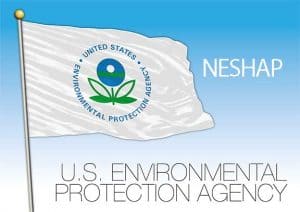 EPA has issued a revised NESHAP standard for municipal solid waste landfills. The new rule reflects EPA’s conclusions regarding the residual risk and technology rule, resolves confusion created when the previous rule was not updated at the same time as the landfill NSPS and updates landfill gas well head criteria for temperature. EPA is also clarifying that the standards are applicable during periods of startup, shutdown and malfunction, and requiring electronic reporting of performance test results.
EPA has issued a revised NESHAP standard for municipal solid waste landfills. The new rule reflects EPA’s conclusions regarding the residual risk and technology rule, resolves confusion created when the previous rule was not updated at the same time as the landfill NSPS and updates landfill gas well head criteria for temperature. EPA is also clarifying that the standards are applicable during periods of startup, shutdown and malfunction, and requiring electronic reporting of performance test results.
This action finalizes the residual risk and technology review (RTR) conducted for the Municipal Solid Waste (MSW) Landfills source category regulated under National Emission Standards for Hazardous Air Pollutants (NESHAP) contained within 40 Code of Federal Regulations (CFR) Part 63, Subpart AAAA. Additionally, the U.S. Environmental Protection Agency (EPA) is taking final action to:
The EPA is also finalizing minor changes to the MSW Landfills NSPS and Emission Guidelines (EG) and Compliance Times for MSW Landfills contained within 40 CFR Part 60, Subparts XXX and Cf. Specifically, the EPA is finalizing provisions to the most recent MSW Landfills NSPS and EG that would allow affected sources to demonstrate compliance with landfill gas control, operating, monitoring, recordkeeping, and reporting requirements by following the corresponding requirements in the MSW Landfills NESHAP. According to EPA, these final amendments will result in improved compliance and implementation of the rule and eliminate some of the confusion created by the previous version of the EPA rule.
We’ve pulled this information from the Final Amendments to Air Toxics Standards for Municipal Solid Waste Landfills and SCS will publish an SCS Technical Bulletin on our blog and social media sites. Please contact your Project Manager for details specific to your operation.
Approximately 738 MSW landfills are subject to the NESHAP.
On February 25, 2020, EPA finalized amendments to the 2003 NESHAP for MSW Landfills. EPA issued air toxics standards for the MSW Landfills source category in 2003 that established emission limitations based on maximum achievable control technology (MACT) standards for hazardous air pollutants (HAP) from major and area sources.
The rule required MSW landfills greater than 2.5 million megagrams (Mg) and 2.5 million cubic meters with uncontrolled emissions greater than 50 Mg/year of non-methane organic compounds (NMOC) to install and operate a gas collection and control system (GCCS). Most emissions from MSW landfills come from the continuous biodegredation of the MSW. Landfill gas contains methane, carbon dioxide and more than 100 different NMOC, including, but not limited to, vinyl chloride, ethyl benzene, benzene and toluene.
Based on the RTR, EPA is finalizing no changes to the existing standards because the agency determined the risks to be acceptable with an ample margin of safety to protect public health and the environment. In addition, EPA did not identify any new cost-effective emission controls for MSW landfills. However, EPA is finalizing several minor amendments to reorganize and streamline requirements for MSW landfills that will improve the clarity, compliance and implementation of the rule. These include:
The Clean Air Act (CAA) requires EPA to regulate toxic air pollutants, also known as air toxics, from categories of industrial facilities in two phases. The first phase is “technology-based,” where EPA develops standards for controlling the emissions of air toxics from sources in an industry group or “source category.” EPA bases these MACT standards on emission levels that are already being achieved by the best-controlled and lower-emitting sources in an industry. Within 8 years of setting the MACT standards, the CAA directs EPA to assess the remaining health risks from each source category to determine whether the MACT standards protect public health with an ample margin of safety and protect against adverse environmental effects. This second phase is a “risk-based” approach called residual risk. Here, EPA must determine whether more health-protective standards are necessary.
Every 8 years after setting MACT standards, the CAA requires EPA to review and revise the standards, if necessary, to account for improvements in air pollution controls and/or prevention and to address any residual risks that still remain after the MACT is implemented.
The CAA requires EPA to assess the risk remaining after application of the final air toxics emission standards; known as a residual risk assessment. Based on the completed risk assessment, available health information, and associated uncertainties, EPA determined risks from the MSW Landfills source category are acceptable and provide an ample margin of safety to protect public health. EPA estimates the maximum individual lifetime cancer risk for inhalation for the source category to be less than 10-in-1 million.
The CAA requires EPA to assess, review and revise air toxics standards, as necessary, taking into account developments in practices, processes and control technologies. The technology review of the standards for MSW Landfills did not identify any developments that would further reduce HAP emissions beyond the original NESHAP.
Download a copy of the final rule notice from EPA’s website at the following address: https://www.epa.gov/stationary-sources-air-pollution/municipal-solid-waste-landfills-national-emission-standards.
SCS will publish an SCS Technical Bulletin on our blog and social media sites. Please contact your Project Manager for details specific to your operation.
SCS Customer Support:
800-767-4727
Local Offices or Find a Specialist
Despite the many impacts on our lives right now, our thanks go to the many public and private solid waste management employees, and organizations such as SWANA and the NWRA, for continuing to serve our communities to keep them clean and safe nationwide. Solid waste management is definitely an essential service on the frontline.
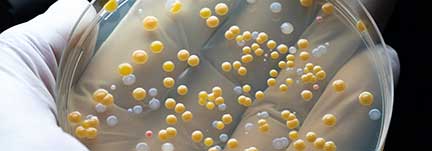
During this COVID-19 outbreak, many employers, property managers, and property owners are tirelessly working to maintain clean and safe environments for tenants and employees. Cleaning contractors and janitorial services are working overtime, expending considerable efforts trying to maintain clean and disinfected workspaces and buildings. While providing their services, they face continual challenges of not having enough information regarding COVID-19 behavior, and the dwindling supply of cleaning and disinfecting agents. Many have inquired about microbial sampling and analytical methodologies to evaluate the effectiveness of these cleaning measures.
Some of us have been here before. Twenty years ago, property managers and tenants faced similar challenges in the wake of anthrax contamination of mailrooms in several prominent buildings. The approach we took then—collecting wipe samples from areas of concern for analysis at a nationally-recognized specialty laboratory—can offer peace of mind and an empirical basis for the evaluation of cleaning/disinfection effectiveness.
While specific testing for viruses, including the novel coronavirus (SARS-CoV-2), is not generally available, it is possible to test environments and surfaces for the presence of surrogate clinical pathogens and bacteria—these should be absent if cleaning and disinfection are effective.
Every building, tenant space, and office work environment is unique, and therefore it is important to develop site-specific plans. Staff collecting the samples should be trained in hazardous incident response, including microbiological and chemical impacts on structures and the environment, and should have the proper personal protective equipment (somewhat scarce at present in many locations).
About SCS Engineers
SCS Engineers is a 50-year-old, employee-owned environmental consulting and contracting firm that designs and implements sustainable and innovative environmental solutions. With 70 offices nationwide and nearly 1,000 employees, we are a full-service provider in the solid waste, hazardous waste, and environmental engineering industries. We study challenges and design solutions; we remediate, build and operate environmental and energy projects and systems; and, we evaluate the public health risk of hazardous materials exposure scenarios. As technologies, industry, and public needs change and expand, SCS evolves to provide innovative solutions to our clients’ challenges.
Most states’ guidance considers SCS’s services as essential to protect public health.
Contact SCS today at 800-767-4727 or for additional information and consultation regarding the effectiveness of cleaning/disinfection at your properties and workspaces in your state. Further information about SCS is on our website at https://www.scsengineers.com/.
To our valued clients, partners, and friends, we would like to pass on our wholehearted concern for you and your families’ well-being. We hope that those affected by the virus recover fully and quickly, and those healthy remain that way.
We look forward to the day we can meet again in a less socially-distant way, but in the meantime, know that we are here to serve and are available to help you carry the load in a challenging time.
The employee-owners of SCS Engineers
Both associations are providing guidance, as many waste management activities must continue. SCS is following association advice, state protocols, and our clients’ recommendations in our own procedures as we continue to perform essential work. We share the SWANA resources and recommendations here and thank them for their dedication. SCS employees should use SCS resources available on the SCS intranet and through our Health & Safety protocol, which reflect the safety precautions advised here.
Reprinted Letter to SWANA Members dated March 23, 2020
As communities and companies throughout the United States and Canada respond to the Coronavirus pandemic, SWANA will continue to provide assistance to its members and the waste industry.
A growing number of states and localities are issuing orders identifying certain industries as “essential” during the pandemic, and these orders typically include the solid waste industry and other categories of employees who may be SWANA members. In those locations, employees and contractors may need to demonstrate proof to law enforcement personnel or others that they work in an essential industry. See this template letter that employers can customize to their needs and provide to employees and contractors. The letter should be on agency/company letterhead and include a contact person and a telephone number to call. The contact person should be familiar with the applicable emergency declarations.
Employees and contractors should carry the customized letter with them at all times, and particularly when they are going to or from work. Several waste industry employees in California in their personal vehicles were stopped on their way to work by law enforcement personnel late last week, but fortunately, their employer had created a letter similar to the attached and the employees were able to show that letter and proceed to their places of employment.
This letter is intended to allow workers to demonstrate that they work in a job category identified as an essential service, including solid waste and recycling operations. It should not be used for any other purpose or by employees that are not actively supporting these operations.
In addition, attached is a notification document for solid waste employers and others to place in their work vehicles to demonstrate they are covered by recent emergency order guidance. It cites the Department of Homeland Security’s Cybersecurity & Infrastructure Security Agency, March 19, 2020 memo that identifies workers engaged in the removal, storage, and disposal of residential and commercial solid waste and hazardous waste as essential infrastructure workers.
Please do not hesitate to contact Jesse Maxwell at or me at if you have any questions about this letter, or need assistance responding to the Coronavirus pandemic. Please stay safe and healthy.
NWRA resources are plentiful and include these:
COVID-19 WORK PRACTICES At this time CDC and OSHA are not issuing waste and recycling specific guidelines for the handling of waste and recycling materials related to COVID 19. If this changes, NWRA will alert its members. Use this industry guidance.
COVID-19 RESOURCES Resources and information provided by agencies and organizations.
Thank you!